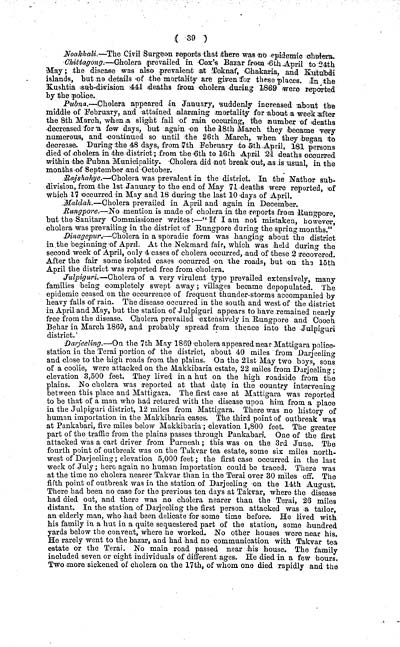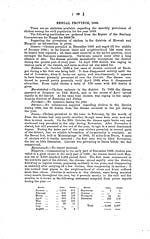Medicine - Disease > Cholera in India, 1862 to 1881
(63) Page 39
Download files
Individual page:
Thumbnail gallery: Grid view | List view

(39)
Noakhali.-The Civil Surgeon reports that there was no epidemic cholera.
Chittagong.-Cholera prevailed in Cox's Bazar from 6th April to 24th
May; the disease was also prevalent at Teknaf, Chakaria, and Kutubdi
islands, but no details of the mortality are given for these places. In the
Kushtia sub-division 441 deaths from cholera during 1869 were reported
by the police.
Pubna.-Cholera appeared in January, suddenly increased about the
middle of February, and attained alarming mortality for about a week after
the 8th March, when a slight fall of rain occuring, the number of deaths
decreased for a few days, but again on the 18th March they became very
numerous, and continued so until the 26th March, when they began to
decrease. During the 48 days, from 7th February to 5th April, 181 persons
died of cholera in the district; from the 6th to 16th April 21 deaths occurred
within the Pubna Municipality. Cholera did not break out, as is usual, in the
months of September and October.
Rajshahye.-Cholera was prevalent in the district. In the Nathor sub-
division, from the 1st January to the end of May 71 deaths were reported, of
which 17 occurred in May and 18 during the last 10 days of April.
Maldah.-Cholera prevailed in April and again in December.
Rungpore.-No mention is made of cholera in the reports from Rungpore,
but the Sanitary Commissioner writes:-" If I am not mistaken, however,
cholera was prevailing in the district of Rungpore during the spring months."
Dinagepur.-Cholera in a sporadic form was hanging about the district
in the beginning of April. At the Nekmard fair, which was held during the
second week of April, only 4 cases of cholera occurred, and of these 2 recovered.
After the fair some isolated cases occurred on the roads, but on the 15th
April the district was reported free from cholera.
Julpiguri.-Cholera of a very virulent type prevailed extensively, many
families being completely swept away; villages became depopulated. The
epidemic ceased on the occurrence of frequent thunder-storms accompanied by
heavy falls of rain. The disease occurred in the south and west of the district
in April and May, but the station of Julpiguri appears to have remained nearly
free from the disease. Cholera prevailed extensively in Rungpore and Cooch
Behar in March 1869, and probably spread from thence into the Julpiguri
district.
Darjeeling.-On the 7th May 1869 cholera appeared near Mattigara police-
station in the Terai portion of the district, about 40 miles from Darjeeling
and close to the high roads from the plains. On the 21st May two boys, sons
of a coolie, were attacked on the Makkibaria estate, 22 miles from Darjeeling;
elevation 3,500 feet. They lived in a hut on the high roadside from the
plains. No cholera was reported at that date in the country intervening
between this place and Mattigara. The first case at Mattigara was reported
to be that of a man who had retured with the disease upon him from a place
in the Julpiguri district, 12 miles from Mattigara. There was no history of
human importation in the Makkibaria cases. The third point of outbreak was
at Pankabari, five miles below Makkibaria; elevation 1,800 feet. The greater
part of the traffic from the plains passes through Pankabari. One of the first
attacked was a cart driver from Purneah; this was on the 3rd June. The
fourth point of outbreak was on the Takvar tea estate, some six miles north-
west of Darjeeling; elevation 5,000 feet; the first case occurred in the last
week of July; here again no human importation could be traced. There was
at the time no cholera nearer Takvar than in the Terai over 30 miles off. The
fifth point of outbreak was in the station of Darjeeling on the 14th August.
There had been no case for the previous ten days at Takvar, where the disease
had died out, and there was no cholera nearer than the Terai, 26 miles
distant. In the station of Darjeeling the first person attacked was a tailor,
an elderly man, who had been delicate for some time before. He lived with
his family in a hut in a quite sequestered part of the station, some hundred
yards below the convent, where he worked. No other houses were near his.
He rarely went to the bazar, and had had no communication with Takvar tea
estate or the Terai. No main road passed near his house. The family
included seven or eight individuals of different ages. He died in a few hours.
Two more sickened of cholera on the 17th, of whom one died rapidly and the
Noakhali.-The Civil Surgeon reports that there was no epidemic cholera.
Chittagong.-Cholera prevailed in Cox's Bazar from 6th April to 24th
May; the disease was also prevalent at Teknaf, Chakaria, and Kutubdi
islands, but no details of the mortality are given for these places. In the
Kushtia sub-division 441 deaths from cholera during 1869 were reported
by the police.
Pubna.-Cholera appeared in January, suddenly increased about the
middle of February, and attained alarming mortality for about a week after
the 8th March, when a slight fall of rain occuring, the number of deaths
decreased for a few days, but again on the 18th March they became very
numerous, and continued so until the 26th March, when they began to
decrease. During the 48 days, from 7th February to 5th April, 181 persons
died of cholera in the district; from the 6th to 16th April 21 deaths occurred
within the Pubna Municipality. Cholera did not break out, as is usual, in the
months of September and October.
Rajshahye.-Cholera was prevalent in the district. In the Nathor sub-
division, from the 1st January to the end of May 71 deaths were reported, of
which 17 occurred in May and 18 during the last 10 days of April.
Maldah.-Cholera prevailed in April and again in December.
Rungpore.-No mention is made of cholera in the reports from Rungpore,
but the Sanitary Commissioner writes:-" If I am not mistaken, however,
cholera was prevailing in the district of Rungpore during the spring months."
Dinagepur.-Cholera in a sporadic form was hanging about the district
in the beginning of April. At the Nekmard fair, which was held during the
second week of April, only 4 cases of cholera occurred, and of these 2 recovered.
After the fair some isolated cases occurred on the roads, but on the 15th
April the district was reported free from cholera.
Julpiguri.-Cholera of a very virulent type prevailed extensively, many
families being completely swept away; villages became depopulated. The
epidemic ceased on the occurrence of frequent thunder-storms accompanied by
heavy falls of rain. The disease occurred in the south and west of the district
in April and May, but the station of Julpiguri appears to have remained nearly
free from the disease. Cholera prevailed extensively in Rungpore and Cooch
Behar in March 1869, and probably spread from thence into the Julpiguri
district.
Darjeeling.-On the 7th May 1869 cholera appeared near Mattigara police-
station in the Terai portion of the district, about 40 miles from Darjeeling
and close to the high roads from the plains. On the 21st May two boys, sons
of a coolie, were attacked on the Makkibaria estate, 22 miles from Darjeeling;
elevation 3,500 feet. They lived in a hut on the high roadside from the
plains. No cholera was reported at that date in the country intervening
between this place and Mattigara. The first case at Mattigara was reported
to be that of a man who had retured with the disease upon him from a place
in the Julpiguri district, 12 miles from Mattigara. There was no history of
human importation in the Makkibaria cases. The third point of outbreak was
at Pankabari, five miles below Makkibaria; elevation 1,800 feet. The greater
part of the traffic from the plains passes through Pankabari. One of the first
attacked was a cart driver from Purneah; this was on the 3rd June. The
fourth point of outbreak was on the Takvar tea estate, some six miles north-
west of Darjeeling; elevation 5,000 feet; the first case occurred in the last
week of July; here again no human importation could be traced. There was
at the time no cholera nearer Takvar than in the Terai over 30 miles off. The
fifth point of outbreak was in the station of Darjeeling on the 14th August.
There had been no case for the previous ten days at Takvar, where the disease
had died out, and there was no cholera nearer than the Terai, 26 miles
distant. In the station of Darjeeling the first person attacked was a tailor,
an elderly man, who had been delicate for some time before. He lived with
his family in a hut in a quite sequestered part of the station, some hundred
yards below the convent, where he worked. No other houses were near his.
He rarely went to the bazar, and had had no communication with Takvar tea
estate or the Terai. No main road passed near his house. The family
included seven or eight individuals of different ages. He died in a few hours.
Two more sickened of cholera on the 17th, of whom one died rapidly and the
Set display mode to: Large image | Zoom image | Transcription
Images and transcriptions on this page, including medium image downloads, may be used under the Creative Commons Attribution 4.0 International Licence unless otherwise stated. ![]()
| India Papers > Medicine - Disease > Cholera in India, 1862 to 1881 > (63) Page 39 |
|---|
| Permanent URL | https://digital.nls.uk/74533694 |
|---|




